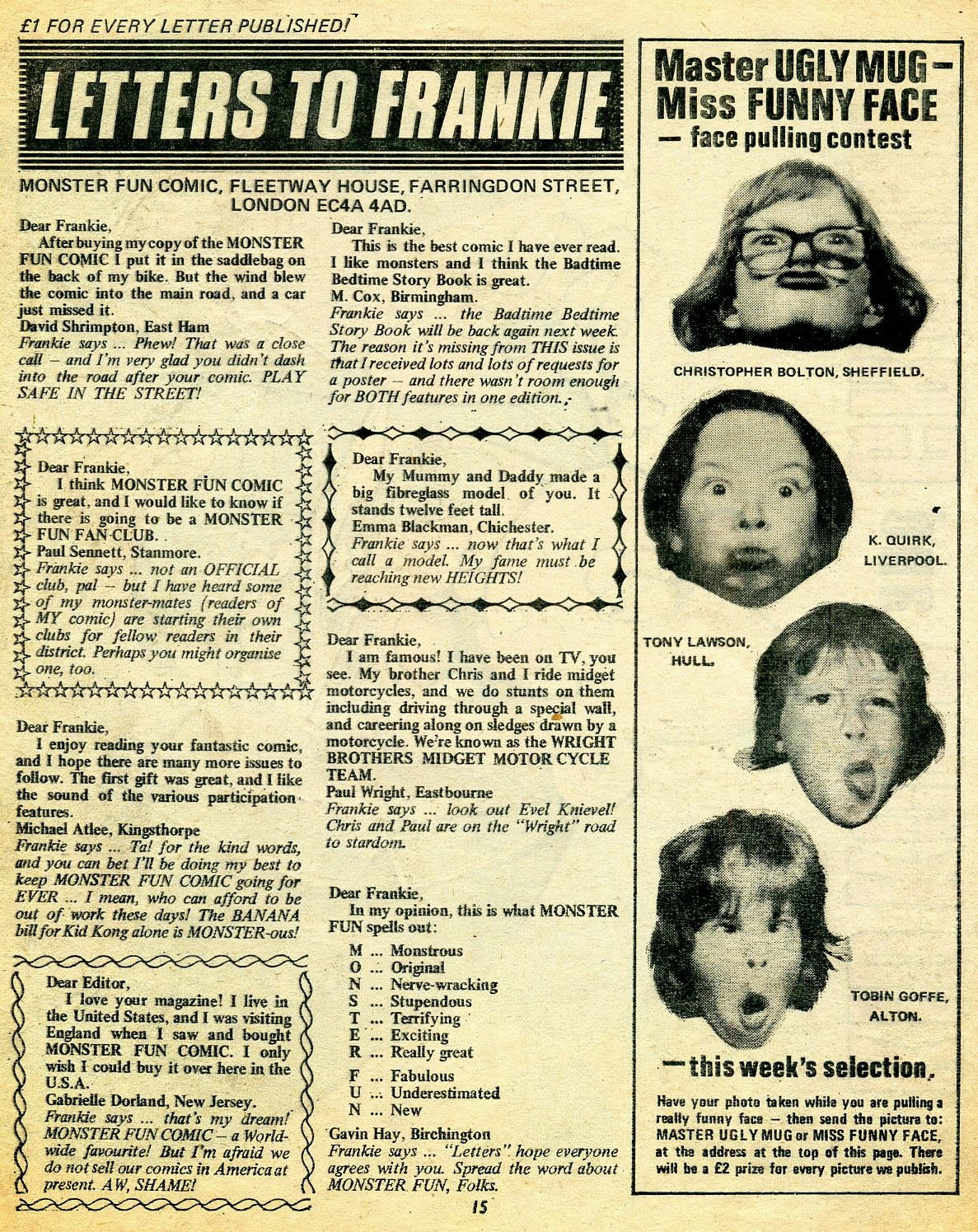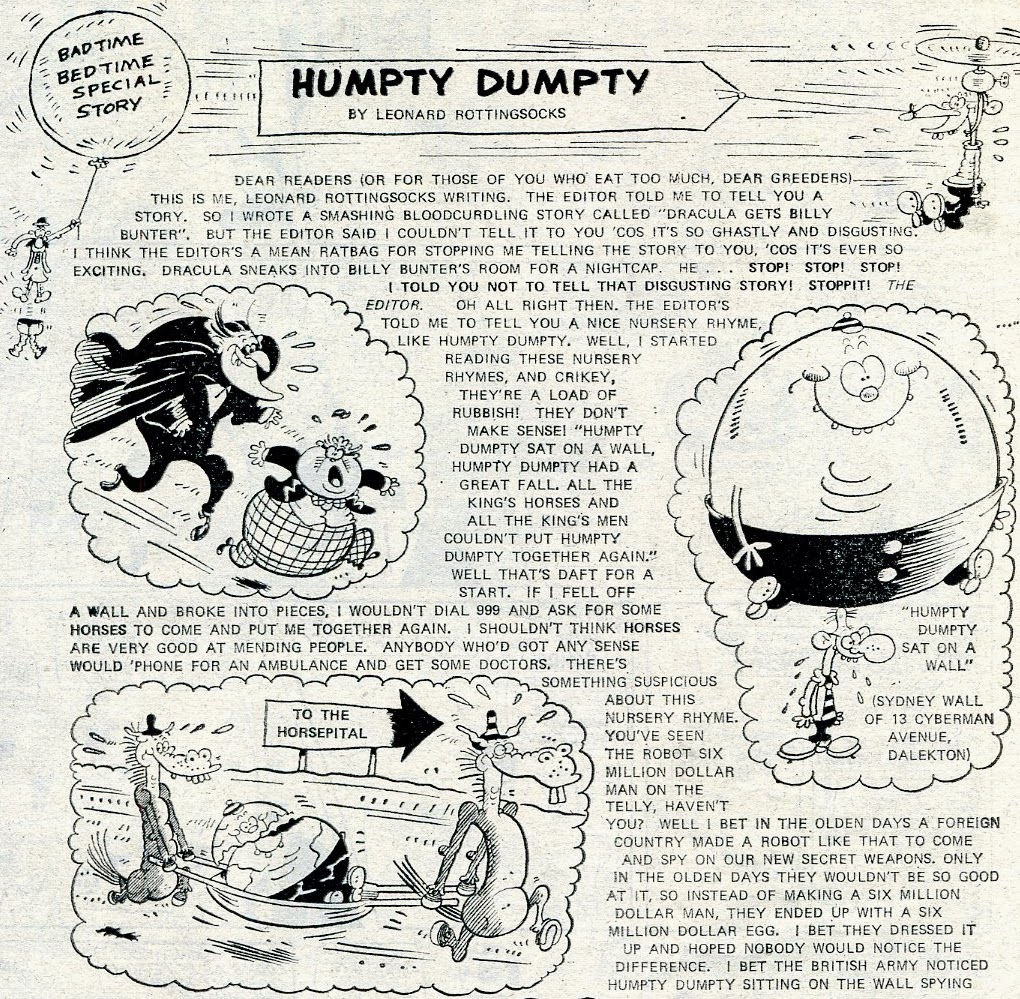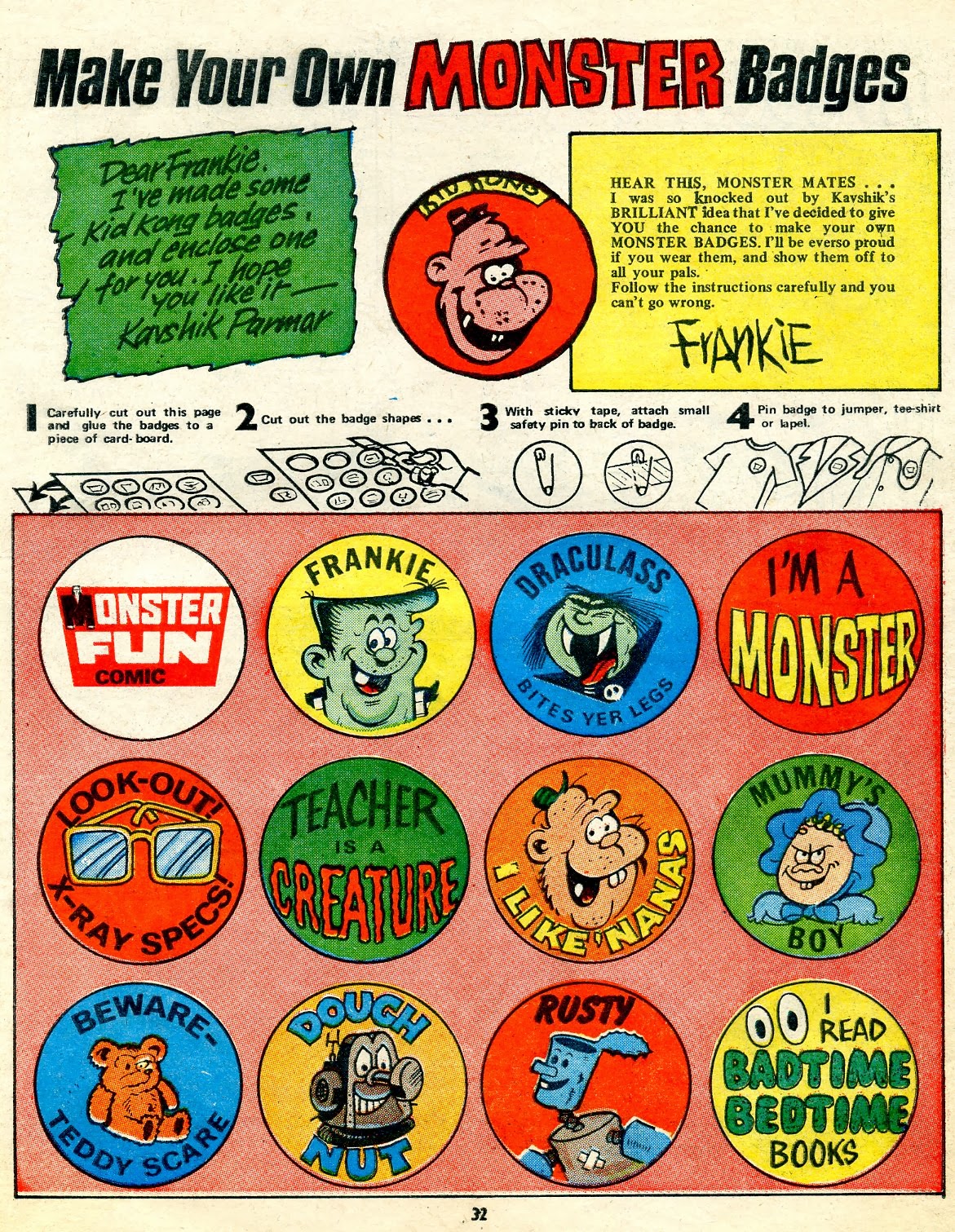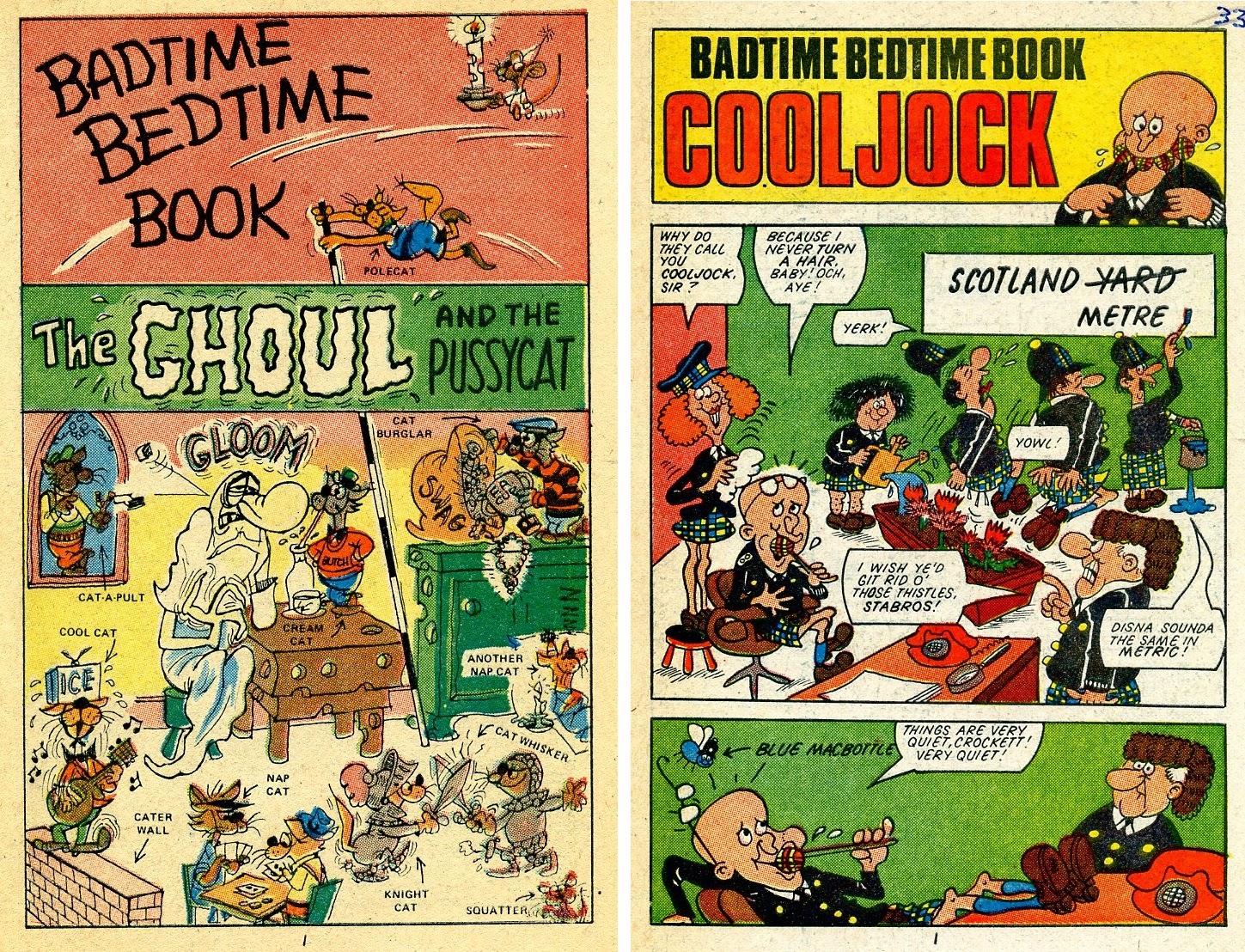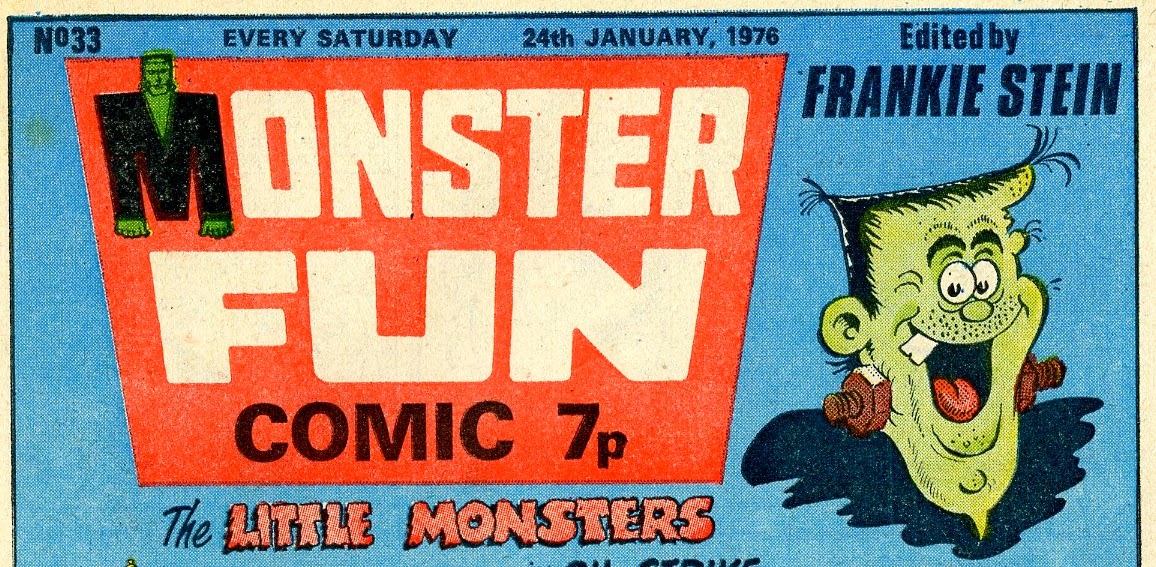Only three strips folded during 1976, they were Art’s Gallery in No. 35, S.O.S. Save Our Stan in No. 39 and reprints of Sam’s Spook in No. 46. Not all of the remaining strips made it to the very last edition, disappearing silently in the penultimate issue or thereabouts; they were Major Jump Horror Hunter (last seen in No. 72), Tom Thumbscrew (the final episode was in the last issue but he was absent for three weeks before that), Meanie McGenie (last seen in issue No. 70 but his appearances had always been sporadic) and The Little Monsters (last seen in issue No. 70). Finish-A-Fiendparticipation feature last appeared in No. 63. I believe readers found it great fun: every week they were asked to finish a freaky figure that an MFC artist had started off for them. Winning attempts were published on a weekly basis and their contributors were rewarded with £2 prizes. Check out a couple of examples below:![]()
![]()
Three new strips took the place of the fallen ones during 1976 – Gums started in No. 35, Freaky Farm in No. 40 and Terror TV in No. 49. Gumsand Terror TV eventually made it to the combined BUSTER AND MONSTER FUN.
![]()
The arrival of Gums in No. 35 put an end to the practice of rotating cover stars (although for the sake of accuracy it has to be said that the majority of covers between issues 23 and 34 had been occupied by the Little Monsters). Gumsentrenched itself firmly on the front page for the remaining lifetime of the paper with a few exceptions: the Monster in the News announcement on the front page of No. 48 (Frankie Stein rejoicing over a clipping from the 3rd March, 1976 edition of The Sunnewspaper mentioning his name), the arrival of Terror TV when the strip was given the front covers in two consecutive issues 50 and 51, the first instalment of Monster-Mix-UpsGame in issue 52 (in which MFC also congratulated itself on its first birthday) and finally Land of the Monsters cut-out pictures for the pull-out wall paper in Nos. 66 and 67. Here are all those non-Gumscovers:
![]()
![]()
By the time he had to prepare the first issues of 1976, Bob Paynter had run out of Badtime Bedtime Books drawn by Mr. Baxendale, so he tried experimenting with a few other artists. IMHO, three of the illustrators (Artie Jackson, Jack Clayton and even Terry Bave) weren’t really up to the task, and the five BBBs that appeared in the first months of 1976 were particularly poorly drawn. Things improved considerably when Bob Paynter discovered Mike Brown who was able to imitate Leo Baxendale's style to perfection. The Editor must have been satisfied, as confirmed by the fact that towards the end of the run the frequency of BBBs was restored to its previous levels. Mike Brown proudly initialled or signed most of the sets, so he must have been pleased with his work as well (check out two examples below). Let’s leave BBBs alone for now because I hope to write a dedicated post or two later on.
![]()
Faced with the deficit of BBBs, the Editor had to use his imagination and think of something to replace them with. By that time the notions of ‘MONSTER FUN COMIC’ and ‘pull-out’ had become inseparable in the minds of the young readers so the magazine had to live up to its image. Posters were the obvious solution. They kicked the year off with Creature Teacher pull-out poster in No. 30, followed Badtime Bedtime Book poster in No. 36, followed by Gumsin No. 38, Teddy Scare in No. 40, X-Ray Specs in No. 44, Kid King visits MF Headquarters in No. 57, Terror TV in No. 60 and The Little Monsters in No. 63. Here is the gallery:
Let’s take a look at other pull-outs offered in MFC during 1976.
Issue No. 33 (24th January, 1976) had a centrespread with a news report under the sensational headline Monsters Invade the Isle of Wight. Illustrated with numerous b/w photos, it was in fact a short article about the construction in 1972 of Blackgang Chine Leisure Centre which had a display of realistic plaster models of pre-historic beasts and soon became a popular tourist spot. Another page with more photos of the attraction can be found in issue No. 36
Issue No. 34 came with a BBB, but it also had this nice Draculass mask on the rear page:
The 4 centre pages of issue No. 35 were given to the advertisement of the first issue of the infamous ACTION – the ‘new boys’ paper of the seventies’.
Issue 42 had this Monster Jigsaw pull-out. The idea was to glue the pull-out to a piece of cardboard, cut it up and make a jigsaw puzzle:
Issue 45 had the pull-out booklet of Man-Made Monsters. It was a collection of images of different giant-size structures and vehicles. Here are the covers:
No. 46 (24th April, 1976) was the Easter issue, so it came with a Monster Fun Easter Egg Race pull-out game with Frankie Stein as the central figure. The pull-out was illustrated and signed by Les Barton.
Issue 49 had the 8-page Frankie Stein's pull-out book of Monster Gags. It was an assortment of visual cartoons by Jim Crocker. Don’t expect to find Frankie Stein inside, his name on the front cover was for promotional purposes only.
The first birthday issue (No. 52, 5th June, 1976) arrived with the first part of Monster Mix-Ups game. Three more parts followed in issues 53-55. Here is what they looked like (all were different, of course):
Again, the idea was to glue the pull-outs to a piece of cardboard, cut them up into 72 cards and play this game:
Issue No. 59 had this pin-up of Leonard Rottingsocks:
The last pull-out proper was Land of the Monsters in issues 65 – 68. The idea was to use the three brightly coloured centrespreads in issues 65-67 to construct a panoramic scene of a pre-historic landscape, then cut out the dinosaur pictures printed in the four issues (if you wish to see how they looked, scroll up to the collage of non-Gums MFC covers above) and arrange them in the scene as one pleased. An example was provided in issue 68:
The wall-paper was quite large: imagine three standard IPC-size centrespreads arranged into a panoramic scene and you’ll get an idea. Drawn by Ron Turner. Here is one piece:
![]()
![]()
Let’s look at some of the interesting stuff in LETTERS TO FRANKIE. Judging from reader feedback, certain characters stood out as clear favourites. Draculass, Kid Kong, X-Ray Specs, Gums and Creature Teacher were among those praised the most. Many readers expressed their admiration for Frankie. His poster in issue 20 was very well received but one common problem seemed to be that Moms weren’t so thrilled about it and wanted it off their kids’ bedroom walls. Some fans asked Frankie about his bolts – did they ever get rusty, did they hurt, would he lose his head without them, etc. They were sorry Frankie had to put up with the bolts and someone even wanted to send him a screwdriver but couldn’t afford it. There were loads of personal questions: someone asked about Frankie’s birthday. Prof. Cube replied it was February 16th, so fans might wish to note the date in their calendars because coming from the creator himself it must official!
One problem that seemed to bother kids in their letters to Leonard Rottingsocks was his smelly feet – he got a few pieces of advice how to deal with the issue but the BBB office boy couldn’t be bothered or was too daft to take them: he said he would happily use talc powder if only he could find one with a cheesy flavour; he also said he tried putting on a new pair of socks every day but complained that after one week his feet wouldn’t fit inside his shoes.
Quite a few readers wrote in to tell Frankie how they persuaded their friends to buy MFC. The Honorary Editor told them that every kid who recruited more readers for MFC was automatically made Honorary Monster Mate.
Many kids wrote in to share their ‘funny’ mishaps – such as landing in a puddle, spilling ketchup or losing a shoe while kicking a ball. I find it quite surprising such letters were printed – perhaps there wasn’t so much of fan mail to choose from after all? Every letter attracted a prize of one pound, and some fans went the extra mile to make sure they got it: one clever boy wrote in to tell he was held captive and needed the money to pay his ransom. Another claimed he was an alien from planet Scaro who needed Earth money to buy MFC with. Yet another ingenious reader used his hypnotist’s skills to hypnotise Frankie into sending him the quid. One more ‘correspondent’ said he was captured by a mad professor who made him take hate potion, so the kid now hated MFC. He needed the money to bribe the professor so that he would release him and he could enjoy MFC again. Fans also demonstrated their creativeness by proposing new story ideas. I liked the one suggesting they introduced Draculad– Draculass’ fellow character who was born underground with a stake in him. There were other grim story ideas too, such as Midnight in the Cemetery and Midnight in the Haunted House.
Letters to Frankie page was sometimes used for important notices, such as this one in issue 64 (28th August, 1976):
It was the second price increase for MFC in 1976 and quite possibly one of the reasons why the paper folded later that year. It coincided with the price increase of WHOOPEE! and BUSTER (possibly also Whizzer and Chips, but as I said earlier, I don’t have copies to check). The crucial difference, however, was that the price of those two increased from 6p to 7p, whereas for MFC the increase was from 7p to 8p. The cover price of WHOOPEE!, BUSTER and WHIZZER AND CHIPS became 8p ten months later starting from the issues dated 16th July, 1977 so this special price policy with regard to MFC is quite puzzling, don’t you think?
The last point I’d like to mention in this overview of fan mail is the eagerness of many readers to find out if a Monster Fun Annual was in the making. Sure enough, the book was produced and became available in shops across the country while the weekly was still up and running (an advert of MF Annual 1977 first appeared in MFC No. 66 (11th September, 1976)). In 1976 IPC also produced its second MFC Summer Special which turned out to be the last. Both the Annual and the Special will be covered here in detail later this year.
The imminent 'important news inside' issue had the cover-date of 30th October, 1976 and starting from 6th November, 1976 Monster Fun Comic was merged into Buster. The centre-spread in issue 73 (30th October, 1976) was the last pull-out, although I am not sure many readers used it as a poster. IPC always made it sound as if it was great news but I doubt if many kids saw it that way…
This is how BUSTER welcomed refugees from MFC on the front page of the first combined number:
The page above shows how BUSTER advertised the arrival of new characters a week before the merger. Here is how long they continued:
Martha’s Monster Make-Up ended on 12th February 1977
Teddy Scare ended on 10th December 1977
Draculassended on 10th December 1977
Terror TV ended on 18th February 1978
Kid Kong ended on 30th January 1982
Gumsended on 12th May 1984
Mummy’s Boy ended on 12th September 1987
X-Ray Specs– lived to the last issue of BUSTER (by which time it was most certainly reprints)
The comic with the combined name of Buster and Monster Fun continued for nearly three years until 25th August, 1979. This, however wasn’t the end of Monster Fun: MF Annuals lasted until 1985 and BUSTER MONSTER FUN Summer Specials continued even longer – the last one I am aware of came out in 1995! BUSTER MF summer specials were produced in parallel with buster summer specials, in other words, there were two Buster specials every Summer between 1977 and 1995.





































































